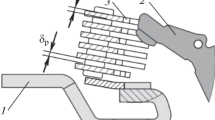Abstract
A method for designing an arc-suppressing system with a deionic grid in automatic circuit breakers is examined. Its essence lies in using the ratio between the characteristics of recovery strength (RS) and recovery voltage (RV) for the moment at which the arc current passes through zero. If the grid is used, the arc is divided into a number of arcs, each of which is characterized by the resistance of a partial arc. The total resistance of the arc greatly decreases the current amplitude and the shift angle between current and voltage, and, as a result, the amplitude of recovery voltage decreases and arc suppression becomes simpler. The processes for suppressing the arc in the circuit breaker in a three-phase circuit are examined. It is shown that, if the arc dies in the first suppressing pole of a three-phase circuit, a voltage triangle deforms due to the resistances of the arcs in the other two poles. When designing an automatic circuit breaker, it is recommended to use reduced coefficients (1.1–1.3 instead of 1.5). The arc-suppressing chamber allows making simpler design decisions (regarding the number and thickness of arc-suppressing plates and the distance between them), to determine the breaking ability of the automatic circuit breaker, and to optimize the parameters of the arc-suppressing system.






Similar content being viewed by others
REFERENCES
Taev, I.S., Elektricheskie apparaty upravleniya (Electrical Control Devices), Moscow: Vysshaya Shkola, 1984.
Taev, I.S., Elektricheskie kontakty i dugogasitel’nye ustroistva apparatov nizkogo napryazheniya (Electrical Contacts and Arcing Low Voltage Devices), Moscow: Energiya, 1973.
Egorov, E.G., Ispytaniya i issledovaniya nizkovol’tnykh kommutatsionnykh elektricheskikh apparatov (Tests and Studies of Low Voltage Switching Electrical Devices), Cheboksary: Cheb. Gos. Univ. im. I.N. Ul’yanova, 2000.
GOST (State Standard) R 50030.2-2010 (MEK 60947-2: 2006): Low-Voltage Switchgear and Controlgear, Part 2. Circuit-Breakers, Moscow: Standartinform, 2012.
Osnovy teorii elektricheskikh apparatov (Fundamental Theory of Electrical Devices), Kurbatov, P.A., Ed., St. Petersburg: Lan’, 2015.
Louiya, N.Yu., Egorov, E.G., Egorov, G.E., and Pryanikov, V.S., Experimental studies of arcing in AC contactors, Vestn. Gos. Chuvash. Univ., 2017, no. 1.
Funding
These investigations have been performed in the framework of a complex project for creating high-technology production at the Cheboksary Electroapparatus Plant with the support of the Ministry of Education and Science of the Russian Federation, project no. 074-11-2018-019 or May 30, 2018.
Author information
Authors and Affiliations
Corresponding author
Additional information
Translated by Yu. Zikeeva
About this article
Cite this article
Egorov, E.G., Louiya, N.Y., Aleksandrov, R.I. et al. Design Features of the Arc-Suppressing System of an Automatic Circuit Breaker. Russ. Electr. Engin. 90, 543–548 (2019). https://doi.org/10.3103/S1068371219080042
Received:
Revised:
Accepted:
Published:
Issue Date:
DOI: https://doi.org/10.3103/S1068371219080042




